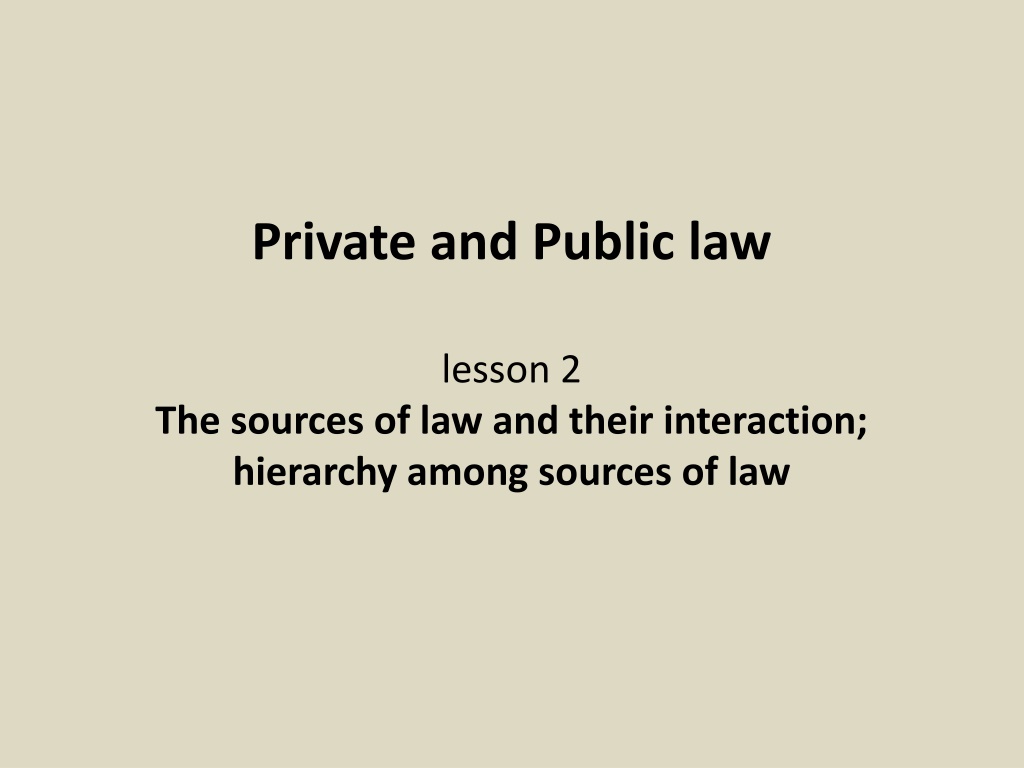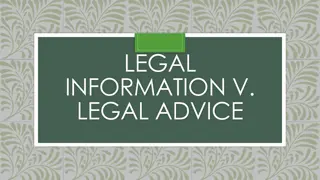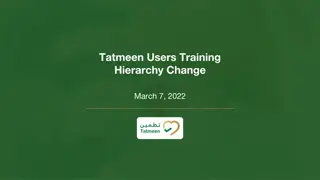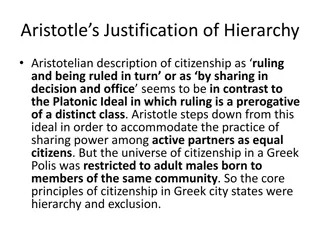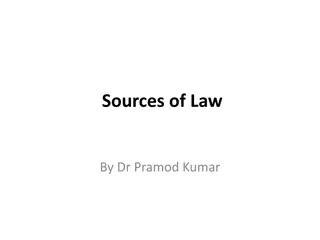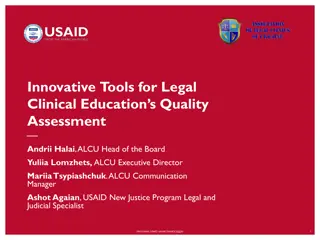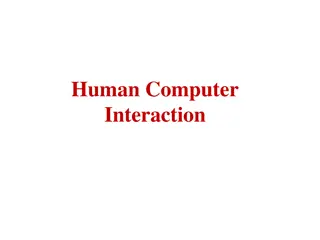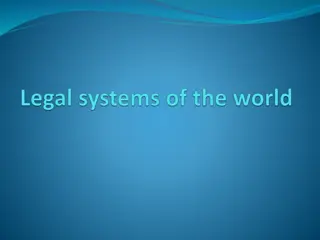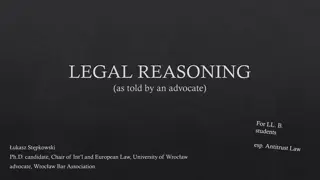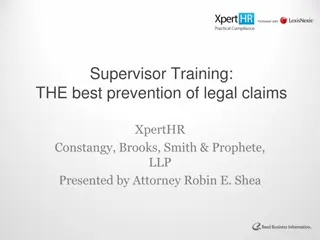Understanding the Hierarchy and Interaction of Legal Sources
Delve into the complex world of legal sources and their hierarchy in private and public law. Explore the essence of norms, their subjects, and essential characteristics like positivism, enforceability, social relevance, and generality. Gain insights into how laws are formulated to govern society effectively and justly.
Download Presentation

Please find below an Image/Link to download the presentation.
The content on the website is provided AS IS for your information and personal use only. It may not be sold, licensed, or shared on other websites without obtaining consent from the author. Download presentation by click this link. If you encounter any issues during the download, it is possible that the publisher has removed the file from their server.
E N D
Presentation Transcript
Private and Public law lesson 2 The sources of law and their interaction; hierarchy among sources of law
The sources of law ______________________________ What is a norm? - the subjects to whom it is addressed : all citizens? Some of them? Single individuals? Public bodies? No addressee ?
The sources of law ______________________________ What is a norm? 1. positivit (in force and effective) 2. coattivit (enforceable) 3. esteriorit (inherent to social life) 4. generalit e astrattezza (general, not linked to specific situations/individuals)
The sources of law ______________________________ 1. positivit (in force and effective) - ability to express an existing interest/value among members of the community - the norm has to be effective - if the norm is generally unobserved, this may mean that it does not express a real interest/value of the community - text of the norm actual content of the norm (as it is applied by Courts and economic players): any conflict?
The sources of law ______________________________ 2. coattivit (enforceable) - Legislator provides for sanctions/fines: the norm has to be applied irrespectively of the individual s will or intentions - examples: Art. 1516 Civil Code (rights of the purchaser); Art. 624 Criminal Code (theft) - Exception: some norms are not supported by sanctions/fines (e.g., norms only setting forth the ultimate aim to be pursued). This does not mean that they are not effective or enforceable . Example: Art. 4 Constitution (right to work)
The sources of law ______________________________ 3. esteriorit (inherent to social life; different from rules regarding each private individual only e.g., moral or religious norms)
The sources of law ______________________________ 4. generalit e astrattezza (general, regulating categories, not dictated by specific situations/needs of a given individual) - Examples: Art. 58 Constitution ; Art. 575 Criminal Code; Art. 922 Civil Code; Art. 18 Code of Civil Procedure - Exception: special norms; exceptional norms (e.g., suspension of procedural terms); legge-provvedimento espropriazione (compulsory purchase): by operation of law or by means of an administrative decision? Practical implication: different regime concerning challenges
Sources of production [e.g., art. 70 Constitution] Sources on production [e.g., art. 72 Constitution]
Institutional sources ( fonti-atto ) Factual sources ( fonti-fatto ) The Constitutional Court is not competent
Direct sources Indirect sources
Sources of law in the Italian Constitution _________________________________
Sources of law in the Italian Constitution _________________________________
Sources of law in the Italian Constitution _________________________________ Some remarks on the list of sources: 1- The Constitution is not mentioned: is it a source ? 2- some sources are regulated by an external source 3- some sources are not expressly contemplated by the Constitution (e.g., military orders, EU-law sources, by-laws of non-territorial entities) 4- The Constitution does not contemplate custom ( consuetudini ) but see art. 1 and 8 of the Pr. to Civil Code - and mechanisms enabling implementation of foreign laws into Italian law 5- the need to take a particular action; the state of need ; special situations of urgency and need (art. 77; 13 and 44 of the Constitution)
Sources of law in the Italian Constitution _________________________________ Regulations: - implementing ordinary laws - supplementing ordinary laws - repealing ordinary laws (based on a previous act of the Parliament) - regulating matters uncovered by ordinary laws The Constitutional Court is not competent
Other sources of law _________________________________ riserva di regolamento costituzionale Internal regulations: Supreme Council of Magistrates (CSM) Each Chamber of the Parliament National Council on Economy and Labor (CNEL) The Constitutional Court The President of the Republic
Other sources of law _________________________________ Custom ( consuetudine ) 1. contra legem ; secundum legem ; praeter legem 2. Is desuetudine (custom leading to ordinary laws being disregarded) admissible? 3. The main features of custom : uniform and constantly repeated behavior by the generality of members of the community + opinio iuris ac necessitatis 4. The gathering of custom laws: do registers have formal authority? [Art. 9 Pr. to Civil Code: registered custom is assumed as existing, unless contrary evidence is provided] 5. Constitutional custom? Supplementing (or amending?) the Constitution; creating new institutions
Other sources of law _________________________________ Case law 1. the Italian legal system only contemplates codified sources of law, but case-law is extremely important 2. example: Art. 923 Civil Code (possession of abandoned goods) 3. What if several norms seem applicable? 4. Is interpretation affected by subjective factors? 5. So, is case law a source of law?
Other sources of law _________________________________ Case law (follows) 6. Art. 2909 Civil Code: the Court decisions bind all parties, their successor and assigns, as well as any third party involved 7. the role played by the Supreme Court (uniformity in the application of law). Are there binding precedents? 8. May the Judge base his/her decisions on equit ? (a) the parties so request and the dispute involves disposable rights; (b) the dispute value is lower than a given threshold. If so, may the Judge create law?
Other sources of law _________________________________ National labor agreements 1. Article 39 Constitution: collective agreements entered into by registered Unions bind all persons belonging to the relevant category 2. Individual labor agreements bind the relevant parties only 3. Collective agreements may not be in contrast with laws or general regulations (which, in turn, may not regulate matters covered by such agreements in detail). However, in certain matters, the intervention of the legislator is essential (as stated by the Constitutional Court: e.g., minimum wages)
Other sources of law _________________________________ The opinion of scholars? 1. it is not a source of law 2. It may strongly influence the views taken by Courts and by other players ( indirect application)
Interaction among sources of law: criteria _________________________________ - Hierarchy - Chronology - Segregation of powers
Interaction among sources of law: criteria _________________________________ General principles: 1. Constitutional laws are preeminent (Art. 2 of the provisions regarding law in general) 2. Without prejudice to point 1, ordinary laws (issued by the Parliament) are preeminent (reserved matters) 3. Government may issue decisions assimilated to ordinary laws ( decreto legislativo and decreto-legge ). These are legitimate within the limits set out by ordinary laws
Deregulation _________________________________ 1.- Regulations repealing existing norms 2.- Regulations setting forth rules regarding Ministries internal organization 3.- Annual measures on deregulation 4.- Regulations implementing EU law into Italian law DEREGULATION PRIVATIZATION DEBUREAUCRATIZATION
